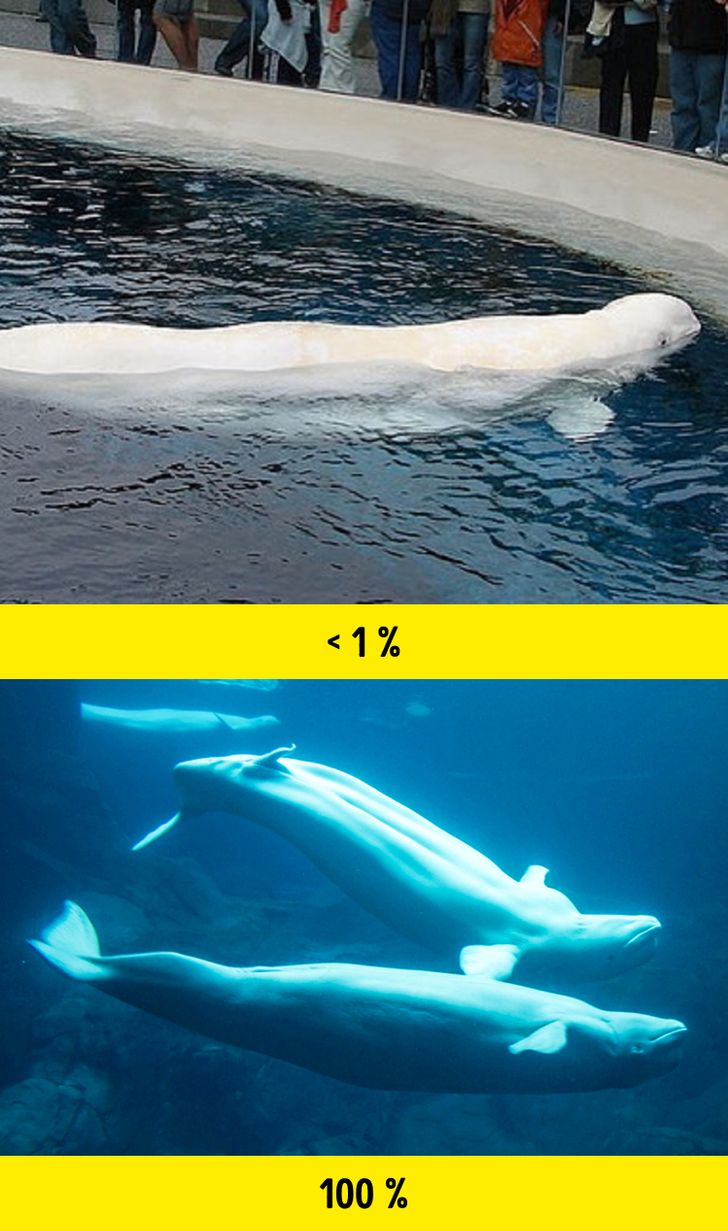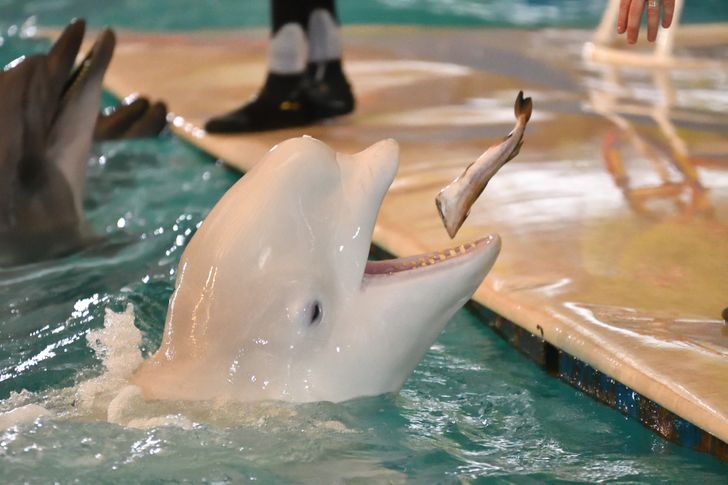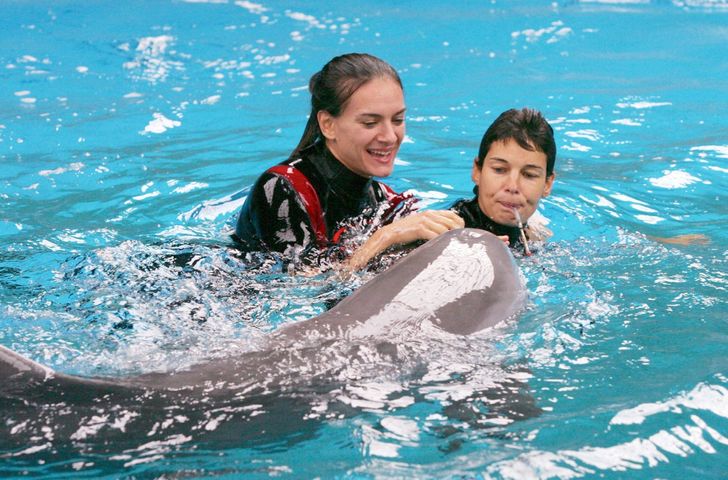#5 is painful to watch!
I would never pay for this show, this is not fun to watch how a poor animal suffers.
They banned circuses from using animals, ban them from using dolphins too! This has to stop! ?
8 False Facts That Make Us Believe Dolphin Shows Are a Lot of Fun

The average life expectancy of dolphins in the wild is 20-30 years, and when they live in captivity, these numbers shrink by at least 2 times. And some animals can only live in a swimming pool for several years. Without making it public, dead dolphins are replaced with new ones. Because the show must go on, no matter what. A number of countries have passed laws that prohibit dolphin shows, but in some other countries, these shows are still considered normal. It’s just that people often don’t understand what happens behind the scenes of these shows.
Bright Side figured out what perceptions people have who visit these parks. Often, the marketing done by these attractions convinces people that the animals are happy. After that, we compared these findings to real facts from the lives of dolphins, beluga whales, orcas, and other animals. It is possible that some (if not many) of these facts will seem shocking.
Myth № 1: Dolphins smile which means they are happy.
The misconceptions are mostly about bottlenose dolphins that are often seen in entertainment shows. However, their “smiles” are nothing more than the anatomy of their jaws which creates the illusion of a constantly happy and friendly creature.
In fact, dolphins don’t like to entertain people. They “smile” both when they are happy and when they feel terrible. They physically can’t look unhappy.
Myth № 2: The animals are friendly and they squint because they are happy.
Just look at the ulcer on the baby orca’s skin.
Different chemicals are used to disinfect swimming pools and most of them contain chlorine. When chlorine is in the water and it has a chemical reaction with animal excrement and turns into a substance that poisons the animals, leading to different diseases and weakened immune systems.
If the concentration of chlorine in the water is too high, it can basically burn the animals’ eyes. The animals can literally go blind. This is why dolphins often swim with their eyes closed, which looks as if they’re just squinting because they’re happy. But the number of chemicals may be not enough to fight harmful bacteria in the water, in which case animals end up with ulcers on their skin.
Myth № 3: Dolphins are calm and not aggressive.
Many people have heard that dolphins use echolocation to move. In small swimming pools, the reflection of sonar waves can seriously impact the psyche of the animal. If you then add the loud music, all the shouting, and applause on top of that, and also the fact that animals are kept prisoners, you will realize that the animals are constantly stressed.
Dolphins are wild animals and their behavior can be unpredictable. Not only are they themselves and their trainers in danger, but the visitors are as well.
Myth № 4: Animals swim in big pools.
In the wild, dolphins and orcas swim about 160 kilometers per day and dive very deep. No matter how big artificial swimming pools look are, animals get access to less than 1% of the room they really need to have a normal life. These curious and smart animals can’t even fully use their brains in such a small area.
As a result, animals are forced to swim circles in the pool, which may result in so-called abnormal behavior. These repetitive movements and rituals lead to different psychological problems in dolphins. There have been cases (quite a lot, in fact) where dolphins hurt themselves.
Myth № 5: They are smart mammals so they perform the tricks easily.
Long scientific studies have proven that dolphins’ brains are very complex. They are self-aware, and they have amazing cognitive abilities. It is not a myth that dolphins are smart and they have complex behavior.
However, the fact that they do tricks in swimming pools doesn’t mean anything. It’s actually because they are motivated with food. Usually, their meals are separated into several portions depending on the number of shows or practice sessions they have and the animals are always kept a little hungry and they soon realize that if they don’t follow their orders, they will be kept hungry. By the way, the food they are given is often very bad. They may be fed with frozen or dead fish that they wouldn’t normally eat in their natural habitat.
Myth № 6: They feel at home in the places where they’re kept.
In their natural habitat, dolphins spend a lot of time and energy looking for and supporting a relationship. They live in big groups. They need a social group in order to have a normal life. So, when you lock a dolphin in a small space with other animals, it is no different from locking a person in a room with other people they don’t know. Forced loneliness drives animals insane.
A trainer who prepared dolphins for shooting the popular TV show Flipper has reconsidered his opinion on keeping animals in captivity after one of his animals died in his presence because of stress. It often happens that ex-trainers will turn around and start protecting the animals they used to train. They will also usually lead or join the fight against keeping them prisoners serving as the main sources of information on the lives of captive dolphins.
Myth № 7: Traveling dolphinariums make it possible for people to learn more about life in the wild.
As we’ve already mentioned, not even the biggest swimming pool can recreate a natural habitat for these animals. When it comes to moving dolphinariums, this becomes even more true, which means that animals have to deal with exponentially more stress. Every time they are moved to a new place, they have to spend 5 to 8 days in small dark barrels. The size of these barrels is just a little bigger than the size of the animals. And there are usually 2-3 animals in one barrel.
Interestingly, the risk for people’s health also increases with traveling dolphinariums. The microflora of these animals becomes more dangerous for people. Bacteria can be easily transmitted by touch, for example, when taking a picture with an animal, or even in splashing water (and the quality of water is much worse than in an ordinary pool).
Myth № 8: Dolphins are real healers.
Often, dolphin therapy includes swimming with animals and some other exercises and this program usually requires that you visit a few times. Dolphinariums actively promote this service, especially to children who need treatment.
The studies that claim that dolphin therapy is useful, usually don’t consider the fact that the effect it has (if it has any effect at all) is short-term and placebo-like. Most of the time, people are just excited because they went somewhere new, they got a lot of attention, people smiled at them, and they felt happy. One of the counterarguments is that people are also often attacked during these sessions.
There are several documentaries that have revealed the secrets of this business, like the Oscar-winning movie The Cove. However, even after watching movies like this, some people say that if you let all these animals back into the ocean, they would die.
This is exactly why nothing will change if people keep visiting dolphinariums. Despite all the risks, it is possible that the animals will be able to adapt to their natural habitat, even though it will take a lot of work and time. So instead, maybe we should look for excuses when considering buying tickets for these shows. Share this article with people who still don’t know what’s behind the scenes.
Have you ever visited a dolphin show? Would you like to go there again after reading this article?
Comments
No dolphin shows for me anymore!
I have been there 3 times, but now as I know what actually goes on there, I don't want to be the supporter of this.
Thank you for this useful information. I have learn something new about dolphins today :)
Related Reads
I Wasn’t Invited to My Son’s Baby Reveal, and It Led to a Painful Discovery

I Refused to Stay After My Husband Secretly Spoiled His Daughter—Then I Heard the Truth

My Boss Saw Me on the Phone With My Sick Son—Now I’m on Thin Ice

I Refused My DIL’s Outrageous Diet Demands—I’m Not an On-Call Chef

I Refused to Let a Mom With a Baby Cut in Line—And Her Answer Was Completely Unpredictable

12 Stories That Remind Us Blended Families Are Love in Its Purest Form

I Refused to Return to the Office After Years of Remote Work — Then HR Dropped a Bombshell

I Paid the Price for Refusing to Give My Window Seat to a Toddler on a 24-Hour Flight

I Just Wanted a Vacation — and Triggered a Full HR Investigation

12 Moments That Show Kindness Isn’t Weak—It’s Power in Disguise

I Refused to Give Up My Extra Plane Seat to a Kid — Things Escalated Quickly

I Refuse to Sacrifice My Social Life Just Because My Wife Is Tired of Being a Mom




